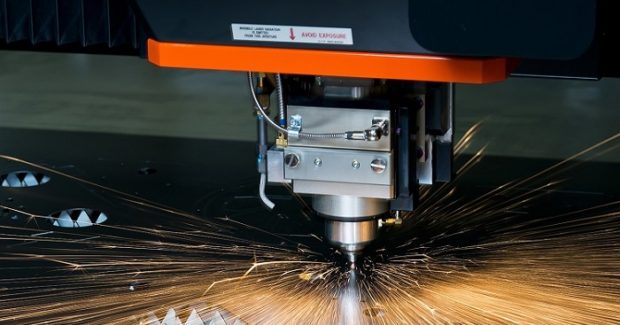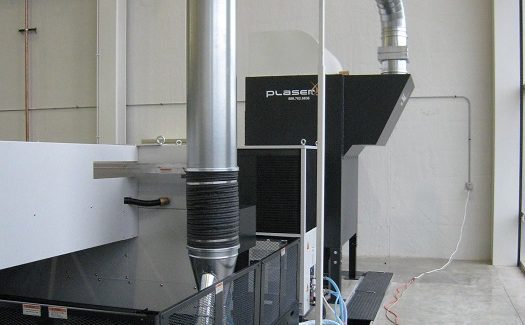How to Control Laser Cutting Dust
How well are your dust collectors keeping up? If you’ve recently upgraded your laser cutting equipment or are experiencing unexplained equipment failures, now is the time to reevaluate your dust collection system. Investing in better dust control now will pay dividends in extended equipment life and better productivity for your laser cutting machines.
Posted: August 12, 2017
Laser cutting is one of the dustiest jobs on the factory floor. How well are your dust collectors keeping up? For many manufacturers, the answer is “not as well as you think.” This is especially true for shops that are making the switch from CO2 laser cutting machines to newer fiber lasers. Dust collectors sized for CO2 lasers may not provide enough collection efficiency for similarly sized fiber lasers. Integrated systems provided by the laser manufacturer are not always up to the task, either. Here’s what your shop needs to know about proper sizing of dust collection equipment for laser cutting applications.
THE HIDDEN PROBLEMS CAUSED BY LASER CUTTING DUSTS
High speed precision cutting turns metal into airborne particulates in the blink of an eye. Because these machines work so fast, large volumes of metal dust can be created in a very short period of time. But since lasers are typically enclosed, the problems caused by ineffective dust collection aren’t always immediately obvious. For enclosed lasers and other CNC machine tools, dust is a largely invisible problem. Since dust is contained inside the enclosure, it is not a health and safety concern for employees and does not create a dirty work environment. However, the impact on the equipment itself is another story. Failing to properly control the dust can cause big problems over time.
“We have some expensive laser cutting equipment,” says David Terry, an engineering and projects manager at Tru-Form Steel and Wire, Inc. (Hartford, IN), who explains how their company learned this the hard way. “These machines have a lot of precision moving parts. When abrasive dust gets into the components inside the enclosure, it can cause a lot of damage.” He notes that Tru-Form had to have parts replaced on his laser cutters more than once while they were still under warranty due to abrasive dust, and estimates that repairs would have cost several thousand dollars each time if they had not been covered by warranty.
While machine repairs can be expensive, the resulting downtime is even worse. For shops running on a 24/7 production schedule, the dust collector can become the limiting factor in productivity. “When a machine is down, it’s a really costly scenario,” adds Terry. “There are only so many hours in a day. If you’re scheduled to have 20 hours of production in a day and a repair takes the machine down for six or eight hours, it’s really difficult to make up that time and get production schedules back on track. Losing a day or more to wait for parts and repairs can be disastrous.”
COUNTING THE COSTS OF POOR DUST CONTROL
Failing to control laser cutting dust results in both direct and indirect costs for manufacturers. Properly sizing the dust collector for the amount of dust produced will help manufacturers avoid these hidden costs. Some of these costs include:
- Damage to the laser: Accumulated particulates can damage the sensors that keep the laser head at the right height from the cutting surface, raising the risk of crashing the laser head. They also foul the optical lens on the machine, resulting in a poor quality cut. Finally, dust can get into the linear actuators and create friction as the machine moves, damaging delicate components over time.
- Downtime: Inadequate dust control will result in more production shutdowns, both planned (for necessary maintenance) and unplanned (as a result of damage to the dust collector or the laser cutting equipment).
- Maintenance costs: If your dust collector is too small, you will need to change the filters more frequently, resulting in a higher burden on maintenance staff. More frequent line shutdowns may also be needed to pulse off extra dust accumulating on the filters.
- Filter costs: If you don’t have enough filter media for the dust you are producing, particulates accumulate faster than they can be pulsed off by the machine, significantly shortening filter life. It will also drive up energy costs as the machine tries to compensate for clogged filters.
CONSIDERATIONS IN DUST COLLECTOR SIZING FOR LASER CUTTING
Proper sizing of dust collection equipment is essential for laser cutting operations. If you purchase more power than you need, you’re wasting your money. If your system isn’t powerful enough, you’ll end up paying more in the end through equipment downtime, repairs and maintenance. Dust collector sizing depends on several factors:
- Amount of material removed per cut: During laser cutting, a thin slice of material is actually vaporized, creating the cut. The volume of dust produced in this process depends on three factors: the width of the kerf (the slit created during cutting, which represents the amount of material removed); the thickness of the metal; and the length of the cut. This is often expressed as a formula: Kerf x Thickness x Length = Total Material Removed.
- Cutting speed: Speed is generally dependent on the total wattage of the laser cutter; the more powerful the machine, the faster it can move through the metal, and the faster dust will be produced.
- Production schedule: The amount of dust produced over the course of the day depends on the number of hours the machine is running. Manufacturers operating equipment 24/7 will need a much bigger collector than those running only one shift a day.
- Type of laser: Newer fiber lasers have some significant differences when it comes to dust production compared to their CO2 counterparts. The width of the kerf with fiber is generally narrower than the kerf for CO2 lasers, meaning less material is removed with each cut, especially when working with thinner materials. However, fiber lasers are usually faster than equivalent wattage CO2 lasers. When cutting with oxygen this difference may not be noticeable, but when cutting with nitrogen or shop air the cutting speed may be two times to six times the speed of an equivalent CO2 laser. This means that a fiber laser will produce significantly more dust per minute than a CO2 laser of equivalent wattage, even if it has a narrower kerf.
SELECTING THE RIGHT DUST COLLECTOR FOR YOUR APPLICATION
In evaluating dust collector capacity, there are two variables that manufacturers need to understand:
- CFM: The volume of air you are moving per minute is referred to as CFM (cubic feet per minute). Your CFM requirements are directly related to the rate at which particulates are produced and the total volume of air in the space that you need to clear. You need to make sure that your CFM is adequate to turn over the air in your space at a rate that keeps particulates at acceptable levels. Properly sizing enclosures for your laser cutting equipment will minimize the CFM required to effectively control the dust in the enclosure.
- Filter media: Filter media is measured in square feet of filter material. The ratio of CFM to filter media is known as the air-to-media or air-to-cloth ratio. In general, the more particulate you are producing, the lower your air-to-cloth ratio should be (or, the more filter media you need for your CFM). If you do not have enough filter media, particulates are driven deep into the filter before they can be pulsed off, causing rapid clogging and reducing filter life.
For most laser cutting applications, manufacturers should look for an air-to-cloth ratio between 1.0:1 and 1.6:1. Processes that produce heavier particulate loads – thicker materials, continuous production or higher velocity – may need even lower ratios, between 0.5:1 and 0.75:1.
IS YOUR DUST COLLECTOR UP TO THE JOB?
Dust collector sizing for laser cutting is often poorly understood by both end users and laser cutting equipment suppliers, especially when it comes to newer fiber cutting machines. Older rules of thumb that have been used for decades for CO2 lasers do not necessarily translate to newer machines. Many shops are now making the switch from CO2 to fiber. Often, they assume that their existing dust collector can simply be hooked up to the new machine. This can be a costly mistake. Manufacturers should also reevaluate dust collection equipment if they are moving to a laser with higher wattage. One shop we were working with developed problems with their laser cutters shortly after moving from a 4 kW laser to a 6 kW laser. A dust collector with a lower air-to-cloth ratio (more filter media) solved the problem.
An experienced air quality engineer can help you evaluate your processes and determine the right size collector for your application. For example, our Plaser Series comes in a range of sizes to meet the needs of both CO2 and fiber laser cutting applications. Lasers cost many times more than dust collectors. If you’ve recently upgraded your laser cutting equipment, or if you are experiencing unexplained equipment failures, now is a good time to reevaluate your dust collection equipment. Investing in better dust control now will pay dividends in extended equipment life and better productivity for your laser cutting machines.


















